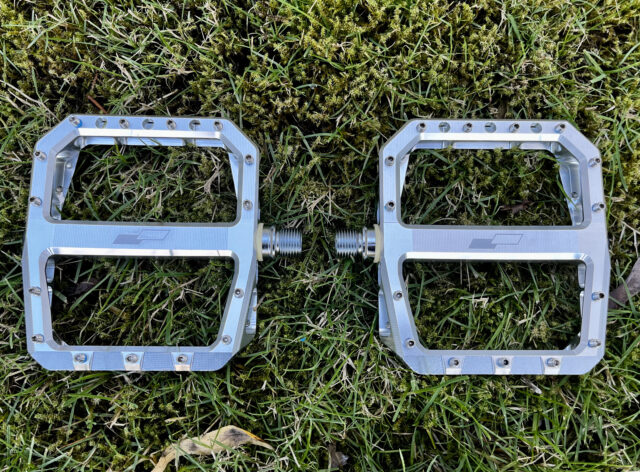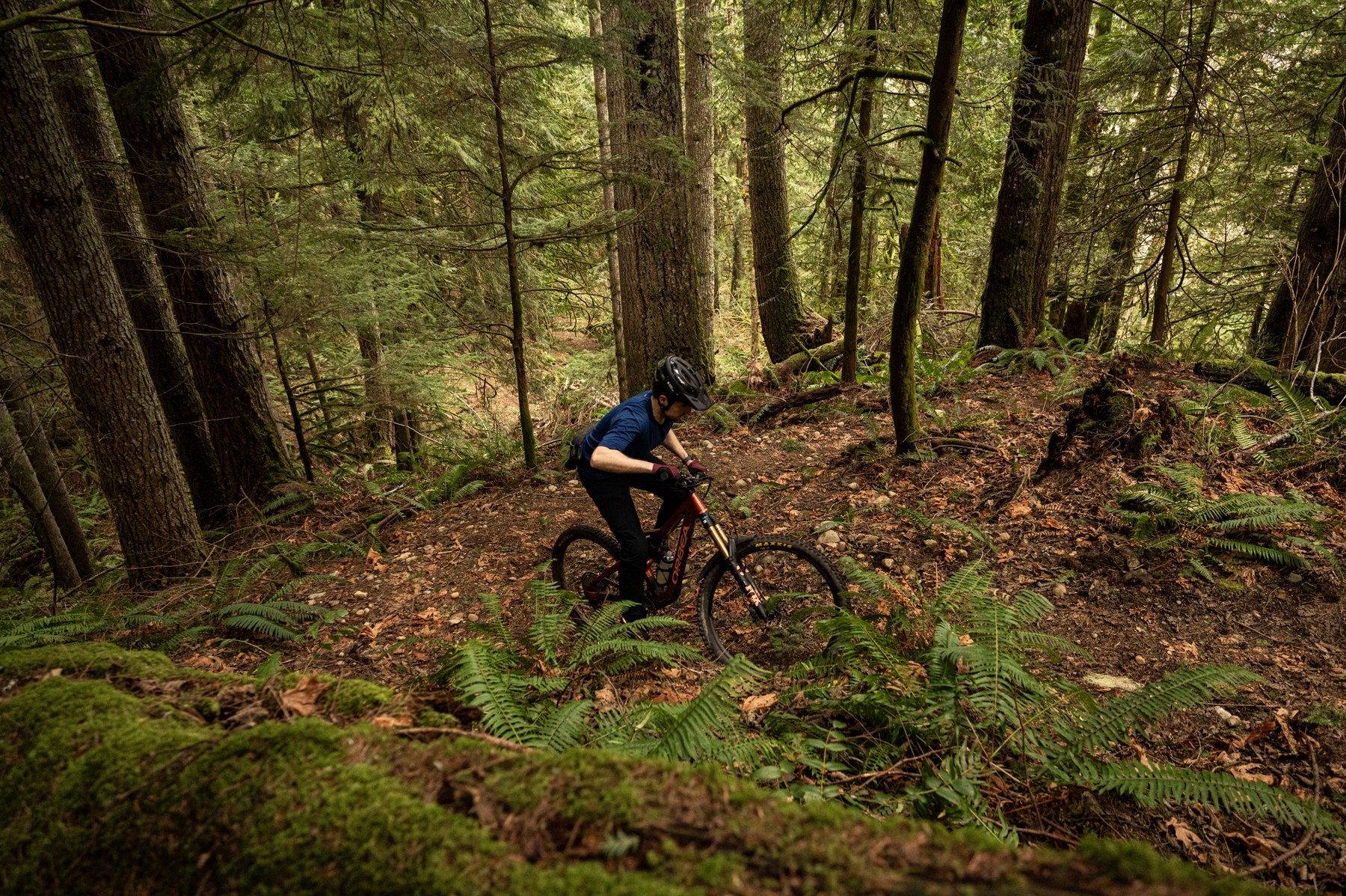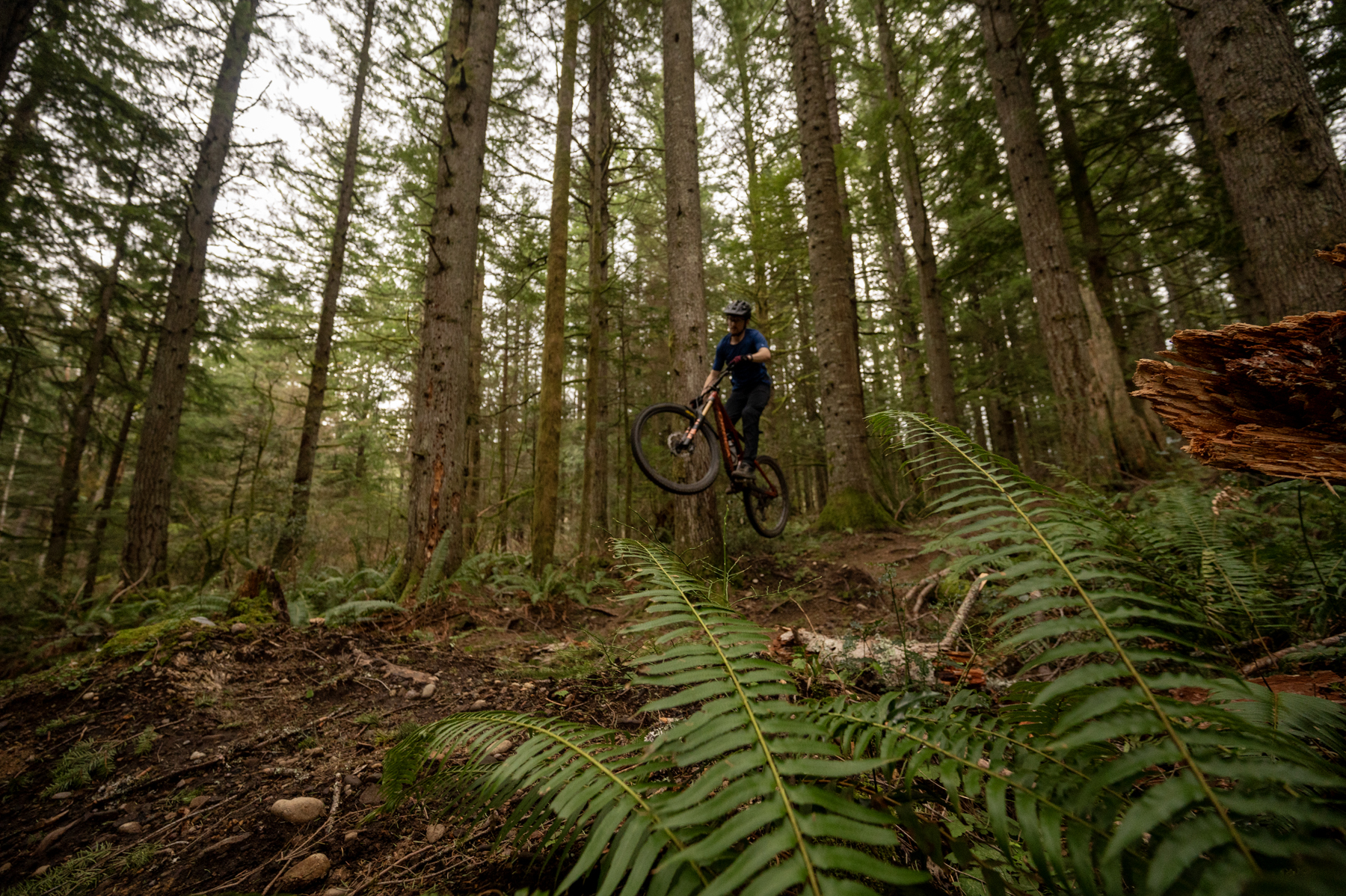Sensus Crue Flat Pedals
MSRP: $189.00
Test Location: Washington
Test Duration: 2 Months
Reviewer: 6’, 160 lbs / 183 cm, 72.6 kg | US Men’s size 11 shoe
Blister’s Measured Weight (steel spindles): 202 g per pedal / 404 g pair (7.13 oz per pedal / 14.25 per pair)
Shoes Used: Ride Concepts Tallac & Shimano GF800 GTX

Intro
Sensus, the brainchild of Cam Zink, is primarily known for their longstanding range of grips, saddles, and other bits used by a very impressive roster of gravity athletes. Drawing on their expertise in developing contact points for Freeride royalty, Sensus introduced the Crue pedals as their vision of “the greatest flat pedal ever created.”
With a striking finish, the increasingly rare option of a titanium spindle, and an intricately shaped platform, the Crue pedals have proved to be a secure and supportive option in the world of premium alloy flat pedals — but they also have some key opportunities for refinement. Let’s dig in:

Design
I’ll lead with something I’ve never said before — the packaging of these pedals is absolutely awesome. Many seasoned riders will recognize the faces of the late Kelly McGarry, Jordie Lunn, and Stevie Smith adorning the individual boxes for each pedal, which fit together in a nice slip case. While I’m typically not one to applaud excessive packaging, these are now permanently displayed above my workbench.

The strong first impressions continued with the pedals as well. At 117 mm long by 105 mm wide, the Crue pedals offer a huge amount of real estate for your feet, particularly lengthwise. We’ve been testing the polished silver pedals and I must say, they are properly gorgeous, with their silver pins and nicely machined silver chromoly axle. The machining itself is also quite intricate, with noticeable concavity and a clear emphasis on shaving weight.
At a measured weight of 404 grams for the set — slightly below Sensus’ claimed 411 grams — the Crue pedals are not the lightest pedals in the game, but relative to their sheer size, it’s an impressive number. Discerning riders who have the cash to splash can opt for a titanium spindle for a claimed 70 grams of weight savings for an additional $60, relative to the chromoly option.
A closer look at the Crue pedal reveals an interesting blend of asymmetrical and symmetrical platform designs. The leading and trailing edges are vertically aligned, similar to other symmetrical pedals such as the Deity TMac, but the Crue is shaped asymmetrically along the length of the pedal to taper slightly from the front edge to the narrower rear edge. This allows Sensus to shape the outside edges of the pedal for some extra clearance and deflection away from obstacles.

It’s an interesting take on pedal shaping that I haven’t seen from other major competitors on the market but makes sense as far as following the naturally tapered shape of the foot (wide at the front, narrow at the back) to reduce the likelihood of getting snagged (since that narrow rear edge on the upper face of the pedal becomes the leading side on the bottom). The platform of the Crue also runs fairly close to the crank arm, reducing the Q-factor to further aid clearance, but with the compromise of reducing the width of the rider’s stance.
Sensus opted to keep the orientation of the 15 pins (per side) fairly straightforward, and I was pleased to see pins only around the perimeter of the pedal — my preferred orientation to maximize grip and a concave feel. The pins are nice-looking silver set screws that have resisted rust admirably throughout the test but are otherwise conventional top-loaded pins and could easily be replaced at the hardware store in a pinch. The platform also features quite a bit of true concavity, claimed as 6 mm by Sensus, which I measured as including the pins.

The internals of the Crue are a combination of a large inboard Igus bushing and two cartridge bearings per pedal. The pedals spin quite freely right out of the box, in part because they do not have any sort of additional rubber sealing on the axle — it’s really just the Igus bushing that is supposed to keep out grit. This was a bit of a red flag since I received the pedals in late November for a winter testing period here in Bellingham, but I was curious to see how they would fare in our typically grim wet season.
On the Trail
Stomping my (US Men’s size 11) feet onto the Crue was an uneventful experience from the start — the concavity of the platform is enhanced by the lack of pins in the center of the pedal, comfortably cradling my foot. Many other flat pedals I’ve tried and liked recently, such as the Hope F22 and Chromag Dagga, have gone the route of custom pins to enhance grip, but the shiny silver grub screws of the Crue work well with the pin layout to offer lots of grip while being very easy to source from the hardware store in a pinch. While they don’t quite match the staggering grip of the Chromag Dagga, I would put the Crue solidly in line with the Hope F22 and Nukeproof Horizon Pro Enduro in terms of overall grip.

As mentioned earlier, the Crue’s platform is an interesting blend of symmetrical and asymmetrical, with the leading and trailing edges being non-offset (a-la-Deity TMac) while being tapered lengthwise to bring the outside portions of the pedal away from trailside obstacles while also following the natural shape of the foot.
Some of our crew here at Blister have found that many truly symmetrical pedals tend to want to roll forward underfoot while climbing. On the other hand, I have found more traditionally offset pedals (more length in front of the axle than behind) to tend to roll while descending. In both cases, the tendency to roll is made worse with a smaller platform size (especially lengthwise).
The length of the Crue’s platform (117 mm) helps to keep it from wanting to roll while climbing, relative to what I’ve experienced with other designs like the Deity TMac, and I didn’t experience any pedal roll while descending, either. The Crue presents a solid, sizeable platform that is easy to locate on rough descents even if my foot shifts unexpectedly.
The Crue pedals spent most of their time on my personal eMTB. eMTBs can present a particular challenge for flat pedals in that many designers opt to keep the bottom bracket height low to bring battery and motor weight lower, with the compromise being increased pedal strikes. The narrower Q-factor of the Crue, paired with its tapered platform shape, was impressively effective in reducing pedal strikes. I noticed no real downsides to the Crue’s support or security due to its tapered platform shape, yet I also seemed to be striking pedals less than with the previously installed Chromag Dagga and Nukeproof Horizon Pro Enduro.

The narrower Q-factor of the Crue, however, did present a bit more of a compromise in that it inherently narrows your stance on the bike. Pedals like the Chromag Dagga deliberately feature a large Q-factor to increase the width and stability of your stance, but the Crue can take a bit of adjustment in that it feels tighter toward the crank, slightly reducing stability while improving clearance.
Despite my good experience with the platform shape and design, my experience with the Crue was not all positive. I had my reservations about the lack of external sealing, given that my testing time with the Crue was fully a wet-season affair here in Bellingham. I subjected the pedals to repeated mud immersion, followed by equally routine washings with the garden hose, and about 2 months into their life, the drive-side pedal started to feel quite stiff.

Sensus does not supply the 10 mm socket required to disassemble the Crue, but I was able to find a thinner-walled standard socket that worked just fine, and Sensus indicated that the pedals should be able to be pulled apart with sockets from Harbor Freight. Once I pulled them apart, I could confirm that a notable amount of water and grit had made its way both into and past the Crue’s DU bushing. There was also surprisingly little grease anywhere in the internals, and the part of the axle that rests against the bushing was showing very early signs of corrosion.
While Sensus does make rebuild kits available for a reasonable $16.99, it seems to me like a rubber seal at the axle — a common feature of most other pedals I’ve tried — would be an inexpensive and effective way of getting better weather resistance out of these pedals. Frankly, I’d expect better at this price point, and while riders in dry climates may have fine luck, riders in wetter locales should be prepared for regular service to at the very least re-grease the internals.

Comparisons
Sensus Crue vs. Nukeproof Horizon Pro Sam Hill Enduro
These pedals have a few similarities but feature bigger differences in platform shape and size. The Horizon Pro pedals have a smaller and more heavily shaped platform with thicker, taller pins, but omit any pins in the middle of the pedal, lending a fairly concave feel approaching that of the Crue. The smaller, more heavily shaped, and asymmetric platform of the Horizon Pro means its leading edge doesn’t catch as many rocks — these pedals are a standout in their ability to dodge impacts — and they do resist the tendency to flip while climbing a bit better than the symmetric platform of the Crue. However, the Crue offers a more supportive platform for bigger feet and feels a lot more stable when descending in rough terrain.
Sensus Crue vs. Chromag Dagga
At 120 x 115 mm in size and with the scariest pins in the game, the Dagga still holds the crown as the most stable, grippiest flat pedal that we’ve tried to date. At 492 grams, it’s also one of the heaviest, and it does feel quite flat — removing the middle pins helped, but the Crue handily wins the concavity award. The Crue still offers good support via its long shape and more connected feel via its concavity, but its narrower Q-factor and platform shaping dodge trailside obstacles a bit more effectively, at the expense of some lateral stability. It’s worth noting that Chromag’s G2 axle system offers very good sealing and longevity in our grim Pacific Northwest testing conditions, whereas the Crue’s sealing is much less robust.
Sensus Crue vs. Deity TMac
These two are perhaps the most natural comparison. At 110 x 105 mm, the TMac is shorter lengthwise than the Crue, but otherwise, the Crue’s mostly symmetrical shape with traditional set screw pins and heavy concavity bears a lot in common with the TMac. On the trail, the Crue won me over as the more refined shape, with the asymmetric shaping on the leading edges leading to fewer rock impacts. The longer platform of the Crue also seemed to resist feeling like it wanted to flip underfoot while climbing under power, a sensation that has plagued a couple of us here at Blister when testing symmetrical pedals like the TMac. As with most of the other comparisons here, the TMac has better axle sealing than the Crue.
Sensus Crue vs. Hope F22
These two feel pretty different. The F22 is much lighter than the Crue but also has a much smaller and more traditional offset parallelogram shape. The outright grip of both pedals is excellent. Where the long but smooth pins of the F22 bite a bit deeply into your shoes, the large platform of the Crue offers a more secure feeling when descending while also feeling more concave and allowing your foot to feel like it’s sinking into the pedal. Hope is known for impressive reliability with its pedals, so I’d trust the Hope to need less maintenance in the long haul, but the Crue worked better for my larger feet from an on-trail perspective.
Sensus Crue vs. Specialized Boomslang
These two aren’t similar at all, aside from offering good mechanical grip. The Boomslang prioritizes an ultra-thin platform by employing a large inboard bearing bulge, while also featuring mushroom-shaped custom pins that provide fierce traction. Its usable platform is quite small though, and the Crue pulls ahead with its much more supportive and concave design. Neither pedal scores well for longevity in wet conditions, but the Boomslang requires a custom tool that seems nearly impossible to source from Specialized, whereas the Crue is much more user-serviceable — even if that service is likely required pretty often.
Bottom Line
It’s clear that Sensus approached the task of designing a premium flat pedal with a vision for something a little bit different than what was available on the market. The Crue provides a large platform in a format that does a surprisingly good job of dodging trailside debris — and looks good while doing it. Its narrow Q-factor does give up some of the stability that a wider stance can bring, but the main drawback is the relatively poor weather resistance of the axle design. Riders in dry locales may get along with them just fine, but if Sensus can improve the sealing, the Crue will be a formidable option for just about anyone.
